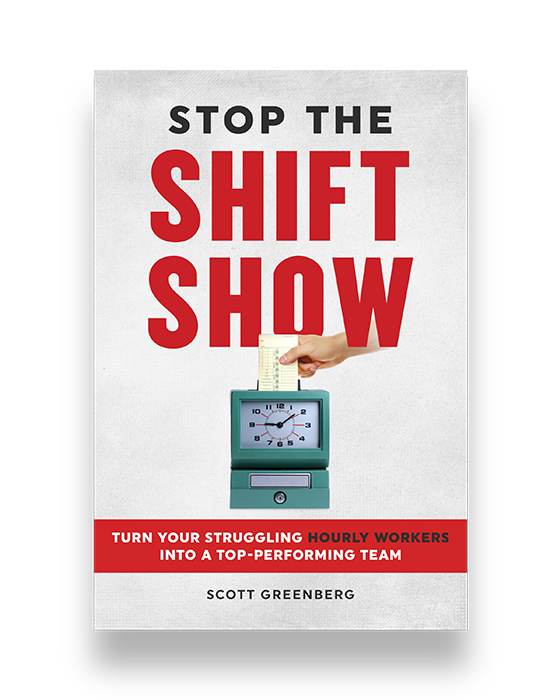Understanding The Differences Between Hourly Employees vs Those on Salary
“I don’t know what’s wrong with these people! I pay them fairly. I buy them pizza and celebrate their birthdays. I treat ‘em like family. And still, they’re constantly calling out. They move slowly. They ghost me. They complain about stress. I can’t believe how flakey and entitled they are! Everyone wants a job, but no one wants to work.”
I hear these comments a lot from my clients and audience members. In many cases, it’s someone with experience managing in a white-collar corporate setting who’s now overseeing teams of hourly frontline employees.
I myself struggled with hourly employees during the first couple of years of running my Edible Arrangements enterprise. I thought my years of being a motivational speaker would enable me to easily inspire and elevate my team. It didn’t. None of the cliches (“There’s no ‘I’ in team!) landed with my staff. The concept of a mission statement was way too abstract. I’d read countless books on leadership and regurgitated their theories on stage. The problem was that my employees hadn’t read those books. They didn’t know how they were supposed to respond to my brilliant Jedi-leadership tactics. Their underperformance and lack of motivation shook me to my core. Was I a hack?
With both my franchise business and my credibility as a leadership speaker on the line, I set out to crack the code on managing frontline employees. That meant putting my assumptions and judgements aside and looking at them with more curiosity. It meant asking deeper questions. It was a lot of trial and error. I also identified and studied other organizations that enjoyed higher retention and better performance with hourly teams, looking for common practices.
Over time, we figured it out. It showed in our retention, employee satisfaction, customer service reviews, and sales. We won awards within our franchise system for both management and service. Profits increased. Most importantly, our stores became more fun, and less stressful.
The tactics we learned can be applied to any hourly work environment and can quickly change the game for those wanting more from their frontline teams. It starts with understanding what makes them different.
Hourly Workers vs Salary Workers
Both groups want to be paid fairly and treated with respect. But salaried employees earn more compensation and more respect. There’s status with not having to punch in. Salaried employees are more likely to work full time, receive benefits, and earn a reliable income, making it easier to plan a life and access credit. They enjoy stability.
Hourly workers are more likely to be juggling multiple jobs, school, or sports. Their lives may revolve around other family members’ schedules. When business is slow, they may have their hours reduced. But even in good times, they may have their hours changed. This uncertainty in both income and schedule necessitates frequent adjustments in their daily lives.
Frontline employees tend to have fewer growth opportunities within their companies compared to their higher-skilled, salaried counterparts. They may feel their employer is less invested in them, making their connection to the company seem more transactional than relational. If they feel less loyalty from the business, they’ll feel less loyal to the business. This lack of deep connection, combined with the absence of benefits like healthcare, makes it easier for them to leave and go work elsewhere.
All of those contrasts, not to mention demographics, age, education, and job experience.
With so many differences in their circumstances and experience of work, frontline employees require a bit more empathy. You can’t expect them to respond to the same approaches organizations rely on to build white collar corporate culture. You need to make adjustments. Here are three proven steps to get started:
Get your values off the poster and onto the floor. Mission and value statements are often way too abstract to have meaning for hourly workers. You may talk a lot about “integrity,” but are you sure they know what that actually means? I encourage my clients to make their values more tangible for frontline workers. For each value, I instruct them to brainstorm a list of behaviors that reflect that value. For “integrity” they might say:
- We treat each other fairly.
- We follow through on our commitments.
- We always tell the truth.
- We admit our mistakes.
- We comply with all laws and company policies.
- We respect confidentiality.
These agreements reflect the value but are easier to understand. It also makes it easier to hold them accountable. Discuss these behaviors and reward employees who consistently demonstrate them. Reprimands should also reference these behaviors as a violation of the values agreement.
Meet your employees’ “soft needs.” Most businesses focus on hard needs – the tangible things people want from a job. Usually this is money, but it may include other benefits. It’s what employees get in exchange for working. “Soft needs” refer to their emotional desires. These include things like recognition, respect, personal development, safety (including emotional safety) and a sense of belonging. They don’t make as much money as those on salary, but they can still enjoy a satisfying work experience. Their soft needs may be different than yours and from each other’s. One person may appreciate schedule flexibility while another longs for a pat on the back. Some may just want to be someplace less toxic than home.
Figure out what drives your individual employees. That’ll make it easier to motivate your team and win their loyalty. Labor dollars may be limited, as is their effectiveness. Employees should be paid fairly, but those businesses who also provide a satisfying work experience (just as they strive to provide a great customer experience) will become employers of choice.
Give Hourly Employees Measurable Work Objectives. Your team’s work may be more physical or repetitive and less intellectual or creative than those in a white collar, salaried setting. Keep your team motivated by giving them clear performance metrics. There’s intrinsic satisfaction in knowing you’ve met or surpassed a benchmark. Employees like being able to keep score. That could mean units manufactured, processed, or sold. Or maybe it’s earning online reviews or a higher Net Promoter Score. I was always surprised that after a long, stressful Valentines’ Day making fruit baskets, my employees always asked how many they sold or created. They were more invested in their work knowing it could be quantified – and that was before even offering them incentives to hit specific benchmarks. They just wanted the emotional payoff of hitting their numbers.
Clarify what’s expected and what success looks like. Then appeal into their natural human desire to beat their own score, what I call “self-competition.” (The alternative is to just keep them busy. That’s a quick way to lose people who hunger for improvement and intellectual stimulation.). Then, continuously coach them to improve.
Managing hourly workers can be tough. You may not believe it’s possible to build a strong, reliable team of frontline employees. I sympathize, but I can’t ignore the results I’ve gotten, or the well-documented results enjoyed by Chick-fil-A, The Ritz-Carlton, In-N-Out Burger, Trader Joe’s, Costco, the Apple Store, and others whose reputations and cultures have been well-documented. They’ve proven it’s possible. You can transform your hourly employees from your biggest challenge into your greatest asset. But only if you’re willing to provide them with greatest management.
Want to learn more about managing hourly workers? Order Scott’s new book “Stop The Shift Show: Turn Your Struggling Hourly Workers Into a Top-Performing Team”!
Or, Click HERE to learn more about Scott live presentations.




